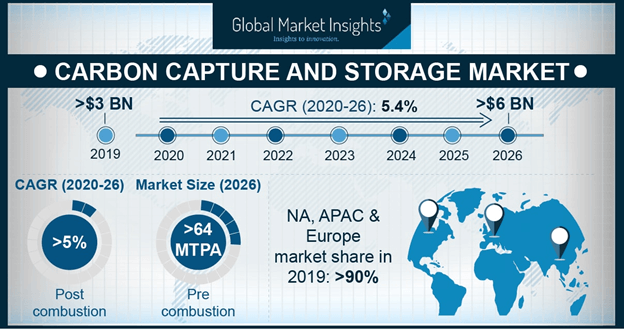Carbon Capture and Storage Market to be driven by a slew of governmental initiatives regarding sustainable energy programs over 2017-2024
Publisher : Fractovia | Published Date : 2017-09-25Request Sample
The globally prevalent trend to reduce carbon emissions is a vitally imperative fact that has been driving carbon capture and storage market. Perpetually impelled by the urgent requirement to brainstorm newer methodologies to uphold energy efficiency, numerous governmental bodies across the globe have been attempting to exploit the CCS technology, which can certainly be deemed one of the major factors fueling carbon capture and storage industry share. A crucial precedent validating the legitimacy of the aforementioned declaration is Scottish energy minister’s announcement regarding the requirement of CCS as a critical tool to accomplish reduced energy consumption across the United Kingdom.
North America Carbon Capture and Storage Market, By Technology, 2016 & 2024 (MTPA)

If reports are to be believed, the Scottish energy minister affirmed that as per the Intergovernmental Panel on Climate Change, the costs to accomplish even a 2°C climate change without CCS would be a mammoth 138% more than the current value. Considering the country’s past records of unfortunate failures regarding the implementation of CCS, it has now become even more vital that the UK government comes up with a robust policy draft that includes working in tandem with the Scottish and other governments, to consolidate UK’s position in the overall carbon capture and storage market. It needs to be remembered though, that the UK government has been extremely tenacious as far as its energy agendas are concerned. In 2008, the government had introduced the Climate Change Act with an aim to lower GHG emissions up to 80% by 2050, from 1990, which has been ideally considered a major step toward the propulsion of the regional carbon capture and storage industry. In 2015, the UK government also suggested that the deployment of CCS technology is likely to save close to USD 38.69 billion by 2024 – an affirmation that is certain to encourage other regional governments to adopt the CCS technology, thereby pushing the overall carbon capture and storage market a few notches higher. What seems to be conclusive from this volley of information is that UK carbon capture and storage industry is likely to witness lucrative growth prospects in the many years ahead, driven by the extensive pipeline of CCS projects and the rising demand in the country for cost-effective technologies to accomplish the set decarbonization targets.
Carbon capture and storage market trends across the Scandinavia belt: Norway betting big on CCS technology
The Scandinavian countries have quite profoundly established their foothold across carbon capture and storage industry. Norway in particular, has garnered the reputation of being quite a powerful player in carbon capture and storage market. The country’s government has imposed exorbitant taxes on carbon emissions since long, encouraged by which, Statoil, the state-owned energy company, has captured and stored close to a mammoth million tons of carbon dioxide under North Sea bed, on an annual basis, since the year 1996. The program brought in a plethora of environmental and monetary benefits for the nation, on the grounds of which Statoil reproduced the process at Snøhvit - its under-sea natural gas drilling station, further consolidating its position in Europe carbon capture and storage industry.
The Scandinavian kingdom, renewed with the success of its CCS program, aimed to educate other geographies in carbon capture and storage market, regarding its technical expertise about CCS, on the grounds of which an alliance was inked in the year 2010, between Oslo and London. In accordance with the same, Britain’s companies were expected to make substantial investments in carbon capture technology through pipeline systems under the sea bed, while the carbon dioxide would be injected in the ground. Through this deal, Norway and Britain aimed to use the existing under-sea infrastructure to transport carbon dioxide directly to storage wells – a move that was forecast to have a substantial impact on carbon capture and storage market. In fact, the Norwegian oil ministry claimed that this sort of system was likely to curb close to 270 million tons of carbon emissions/year by the year 2030 and over 400 million tons by 2050, which gradually encouraged the governmental bodies of other geographies across carbon capture and storage industry to follow suit.
One of the major concerns associated with CCS technology that may possibly hamper the growth matrix of carbon capture and storage market is that the carbon dioxide gas may possibly leak from its permanent storage and return to the atmosphere. However, a group of researchers from the Princeton University have recently published a paper, categorically stating that the CCS procedure would not be prone to leakage or exorbitant costs associated with leaks. The research has also affirmed that the leakage levels, based on the simulations at hypothetical storage locations, would most certainly not lead to extensive costs in the overall energy system. Princeton’s research study thus stands to provide a positive boost to the overall carbon capture and storage industry, which as per research estimates, is forecast to surpass a valuation of USD 6 billion by 2024.
It needs to be remembered that this technology, being at its infancy, has still not been commercially deployed on a large scale across the globe, owing to which the overall carbon capture and storage market is still in the nascent stages of development. Nonetheless, the underlying fact that it is a rather effective strategy for climate change mitigation, in an era where fossil fuels are still being deployed, in itself serves to prove that this fraternity would scale massive heights of success in the forthcoming years. Not to mention, with the backing of regulatory and governmental bodies striving to achieve clean energy goals, it is imperative that carbon capture and storage industry will traverse a path of profitability, having registered a valuation of USD 2.5 billion in 2016.